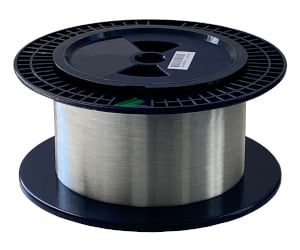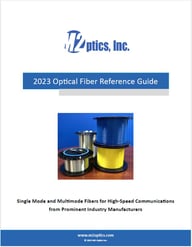Why the Index of Refraction is a Key Technical Parameter To Understand
 The index of refraction (sometimes referred to as the refractive index or IOR) is an essential characteristic of an optical fiber because it plays a crucial role in determining the fiber's ability to transmit light efficiently, maintain signal quality, and support various applications. This article explores several technical parameters directly related to an optical fiber's IOR.
The index of refraction (sometimes referred to as the refractive index or IOR) is an essential characteristic of an optical fiber because it plays a crucial role in determining the fiber's ability to transmit light efficiently, maintain signal quality, and support various applications. This article explores several technical parameters directly related to an optical fiber's IOR.
Signal Transmission & Latency
One of the most essential elements of how a fiber effectively transmits light, the IOR helps to confine the light within the fiber, allowing for efficient signal transmission over long distances. The index of refraction is the ratio of the speed of light in a vacuum to the speed of light in a particular medium, such as air, water, or the glass material of an optical fiber. The higher the index of refraction value, the slower light travels through the medium.
For example, the refractive index of a vacuum is 1. In contrast, the refractive index range of most standard G.652 single-mode optical fibers is in the 1.46 to 1.47 range. The stated IOR value of optical fiber will slightly differ from manufacturer to manufacturer, resulting from proprietary differences in their respective design, material composition, and manufacturing approaches. Since the refractive index value is used to calculate fiber latency, time delay values will change accordingly from fiber to fiber. On this note, it is worth mentioning that transmitting different wavelengths of light and other factors like variances in temperature can also cause a fiber's IOR value to change and must be considered when accurately calculating fiber latency.
- Related Article: Calculating Optical Fiber Latency
- Related Article: Key Considerations When Calculating Optical Fiber Latency
Latency is considered by many to be one of the most important performance parameters in today's fiber optic networks, so anyone designing, installing, or managing fiber-based networks will need to understand the IOR of fiber when seeking to achieve optimal performance or address system timing and sync challenges.
Total Internal Reflection
To transmit light effectively, optical fibers rely on the principle of total internal reflection to contain the light inside and guide it through the fiber. This is achieved when the refractive index of the glass core (the light-carrying portion of the fiber) is higher than the refractive index of the glass cladding (surrounding layer). The difference in refractive indices allows the light to be contained within the core, helping to minimize light loss, also referred to as attenuation, during transmission.
Dispersion
The index of refraction can also influence dispersion, which is the spreading of light pulses as they travel across a length of optical fiber. Dispersion degrades signal quality, so controlling the refractive index profile of an optical fiber is important for mitigating the detrimental dispersion effects to maintain high signal quality.
Bandwidth and Data Capacity
The refractive index profile can impact the modal properties of an optical fiber, which in turn affects its bandwidth and data-carrying capacity. By optimizing the refractive index profile, engineers and scientists can design fibers that support higher bandwidths and data rates, enabling more information to be transmitted over a given period of time.
Application-specific Requirements
Different communications applications may require optical fibers with specific refractive index characteristics. For example, single-mode optical fibers designed for long-distance applications have a smaller difference in refractive indices between the core and cladding. In comparison, multimode fibers used for short-distance applications have a larger difference. The ability to tailor the refractive index properties can help to optimize fibers for specific applications.
Refractive Index of Optical Fibers - Learn More
The index of refraction is an important technical characteristic of an optical fiber, as it directly impacts the optical signal transmission performance, efficiency, and suitability for various applications. By controlling and optimizing the refractive index, optical fibers can be designed to meet specific requirements or objectives for signal transmission, bandwidth, and data rates.
View the IOR and other Technical Specifications of Popular Optical Fibers
Click the Image to Download Your Copy of the Optical Fiber Reference Guide from M2 Optics






